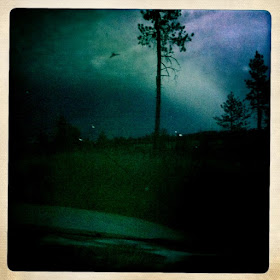This is when we decided to take the bottle of wine to the car and wait it out. It ended up being a couple of hours before it cleared us. I took about 200 pictures to keep myself occupied and a little distracted. Most of them were just black, and I couldn't really tell from looking on my phone that I actually did catch a few bolts.
The experience was one of the most surreal of my life. To be engulfed in deep blackness, and then be completely illuminated by white light. I'm quite grateful.
This lightning storm caused numerous fires that were battled for the rest of the summer. Something like 210 strikes touched the ground in this area that night. Wow.
I wish that every design I did could create the feeling of really being in it, of being electrified by the experience of landscape, as this lightning storm felt. To not be a human standing surrounded by landscape, but an animal, a particle of energy, in the whole of it. We become so removed and think of our selves as separate, when we never are. Whether you are standing on a glacier in Alaska, or can only see concrete for miles, humans are one of the many elements of a complete landscape.
I have been trying to define the word landscape for myself. It makes me sad to think that a lot of people think of neatly manicured shrubs and acutely trimmed and greened lawns when they hear the word landscape. I guess I want to take the word out of the business.
Here is a definition I found for the landscape in relation to people:
Combining both their physical origins and the cultural overlay of human presence, often created over millennia, landscapes reflect the living synthesis of people and place to vital local and national identity. Landscapes, their character and quality, help define the self image of a region, its sense of place that differentiates it from other regions. It is the dynamic backdrop to peoples lives.
This makes me feel really good. I guess I'm a bit of a landscape nerd. Thank you wikipedia.

















